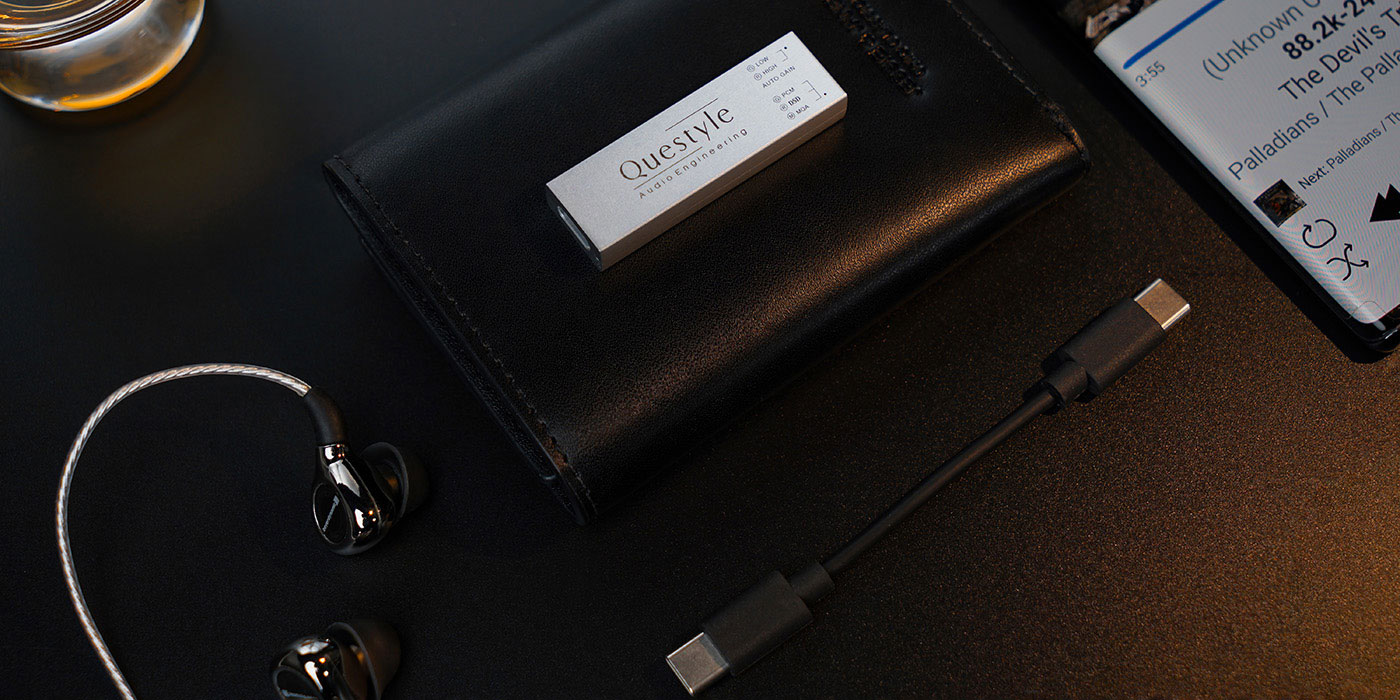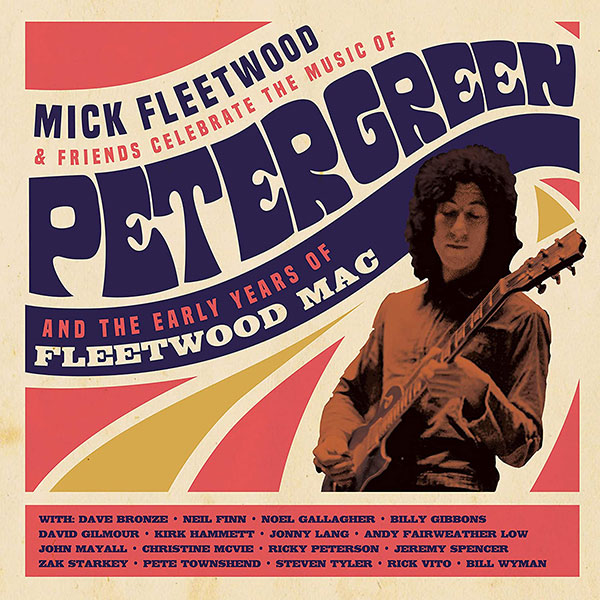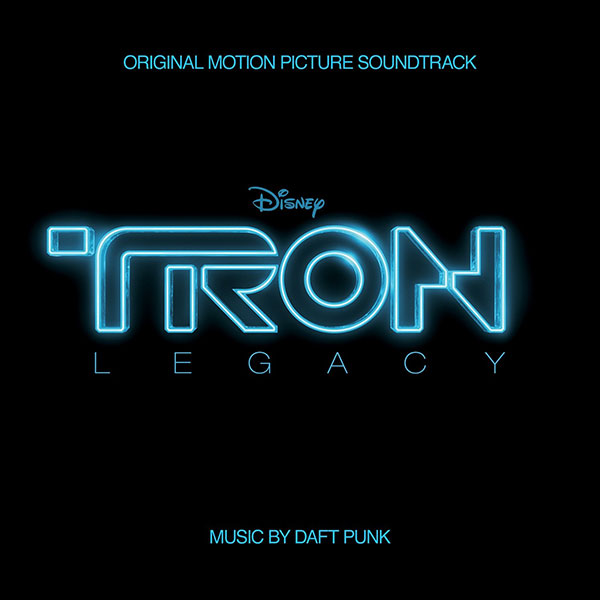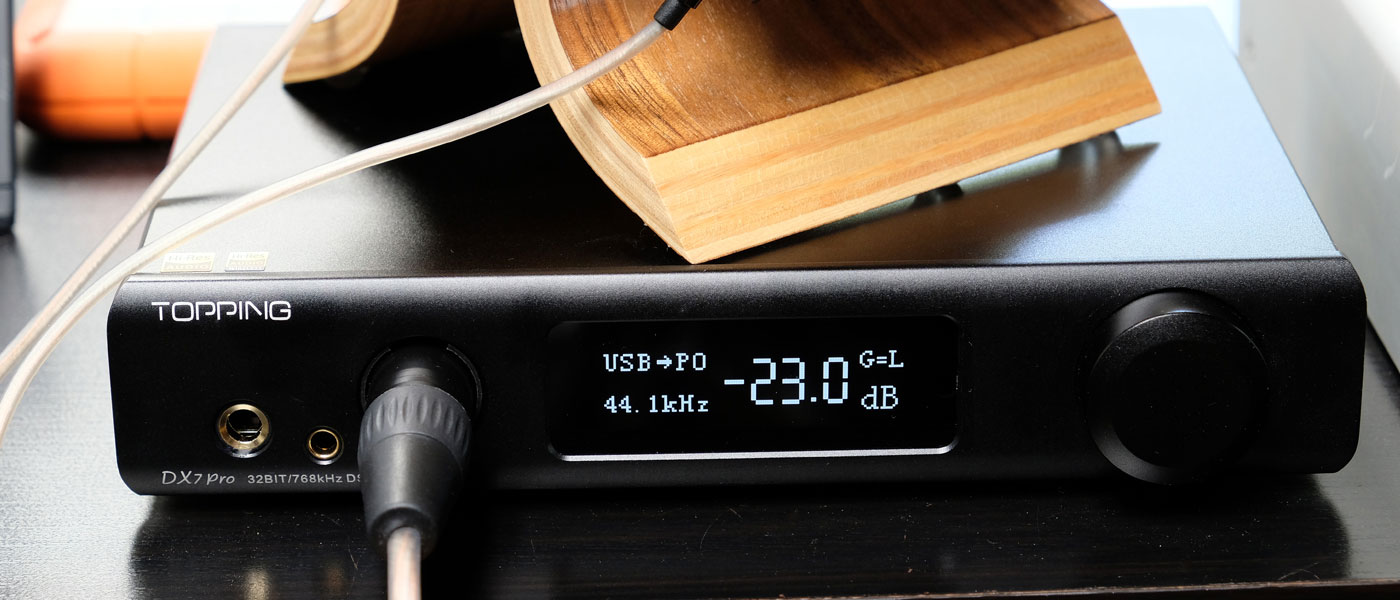
Continuing their knack for producing high-performance audio gear at reasonable prices, Topping brings us the DX7PRO, a well-equipped desktop headphone amp and DAC that claims to punch well above its weight.
Topping DX7PRO Headphone Amplifier/DAC
- Top shelf ESS ES9038PRO DAC chipset.
- Has standard single-ended and two types of balanced headphone outputs.
- Provides enough output to power all but the most demanding cans.
- Bluetooth 5.0 with a wide variety of codec support to pair sources to the DX7PRO.
- Balanced and unbalanced line outputs allow the DX7PRO to operate as a preamp.
- Compact size.
- Wish it had analog line inputs.
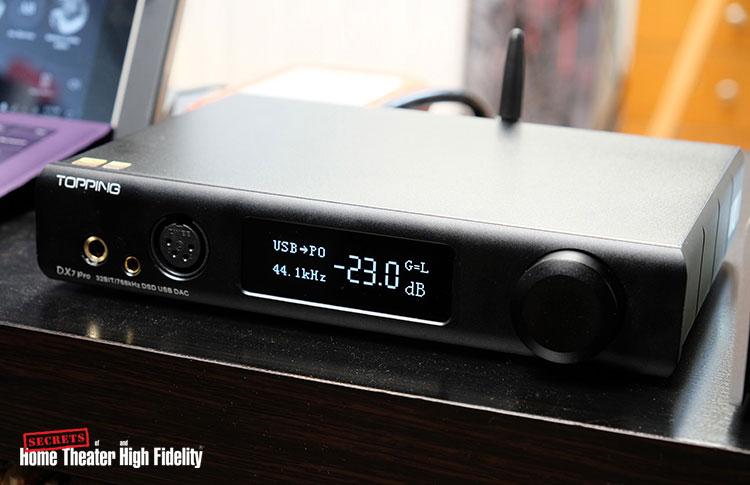
As a serious lover of headphones, I am always interested in products and technologies that allow me to wring the maximum amount of performance and enjoyment out of them. Both for while on the go and when in my studio, if it’s a new audio player, headphone amplifier, DAC, dongle, or whatever, color me curious and eager to try it out. Beyond just straight-line performance, I’m interested in the design, convenience, and usability of a headphone accessory. There are some things like big, high-end tube amps and such where the sheer magnificence of the thing allows you to accept any eccentricities in its usage. But for the day-to-day headphone experience, something dependable, user-friendly, and great sounding is what I appreciate most.
Topping is a company that has a reputation for designing high-performance products that most people can well afford. We recently reviewed their D10s DAC and SPDIF Converter which was a great sounding and handy little product for minimal coin. So, when I was offered the opportunity to review the DX7PRO DAC/Amp, I looked at it as a chance to see what Topping could do with a product a little higher up the scale. Its spec sheet reads like a smorgasbord of all the current and latest tech for listening to music, from mainly digital sources, and ultimately driving your favorite headphones to untold stages of harmonic bliss. With that in mind, let’s see if the Topping DX7PRO is a worthwhile desktop headphone listening solution. The review sample was kindly provided to Secrets by online retailer Aoshida HiFi.
Design:
Fully Balanced DAC/Headphone Amp with Preamp Function.
DAC Chipset:
Single ESS Sabre ES9038Pro Chip.
Manufacturer Freq. Response:
20 Hz – 20 kHz (< - 0.1 dB) All Outputs.
SNR (A-Weighted @ 1kHz):
122 dB (RCA line output), 126 dB (XLR line output)
120 dB (HP Phono), 123 dB (HP XLR)
THD (A-Weighted @ 20Hz – 20kHz):
0.0003% (RCA line output), 0.0002% (XLR line output)
0.0005% (HP Phono @ 32-ohm), 0.0005% (HP XLR @ 32-ohm)
0.0004% (HP Phono @ 300-ohm), 0.0004% (HP XLR @ 300-ohm)
Output Impedance:
4.7-ohm (HP Phono), 9.4-ohm (HP XLR)
Output Level (Volts):
2.0V (RCA @ 0dBFS)
4.0V (XLR @ 0dBFS)
Headphone Output Power:
(HP Phono) 840mW x 2 @ 32-ohm THD+N < 1%
115mW x 2 @ 300-ohm THD+N < 1%
(HP XLR) 1700mW x 2 @ 32-ohm THD+N < 1%
450mW x 2 @ 300-ohm THD+N < 1%
Audio Inputs:
Digital S/PDIF coaxial (RCA):
Up to 24-bit 192 kHz PCM, DSD64 (DOP)
Digital S/PDIF coaxial (AES):
Up to 24-bit 192 kHz PCM, DSD64 (DOP)
Optical digital (TosLink):
Up to 24-bit 192 kHz PCM, DSD64 (DOP)
Digital USB (USB-B):
Up to 32-bit 768 kHz PCM, DSD64-512(Native), DSD64-256(DOP)
I2S (HDMI):
Up to 32-bit 768 kHz PCM, DSD64-1024(Native)
Bluetooth:
AAC/SBC/AptX/AptX LL/AptX HD/LDAC.
Audio Outputs:
Unbalanced analog RCA
Balanced analog XLR
Headphone Outputs:
¼” Phono Unbalanced, 4.4mm Balanced Plug, 4-pin XLR Balanced.
Operating System Support:
Windows, OSX.
Weight:
1.4 kg
Dimensions:
17.8cm x 22.2cm x 4.5cm (W x L x H)
Available Colors:
Black, Silver.
Accessories:
1 x USB Cable
1 x AC Power Cord
1 x Remote Control
1 x BT Antenna
MSRP:
$649.99 USD
Manufacturer Website:
Dealer Website:
Company:
SECRETS Tags:
Headphone Amplifier Review 2021, DAC Review 2021, topping, dac, sabre, balanced, headphone, amp
Checking in at around the physical size of a typical hardback novel, the Topping DX7PRO won’t take up too much real estate on your desk or tabletop. At a weight of 1.4 kg (3.08 lbs), it certainly feels heavier than your average good read and it adds to the subjective impression of quality. The exterior construction is all made of thick aluminum with a simple yet high-quality feel about it. Four rubber feet on the underside prevent the DX7PRO from sliding around or leaving any scratches on your furniture.
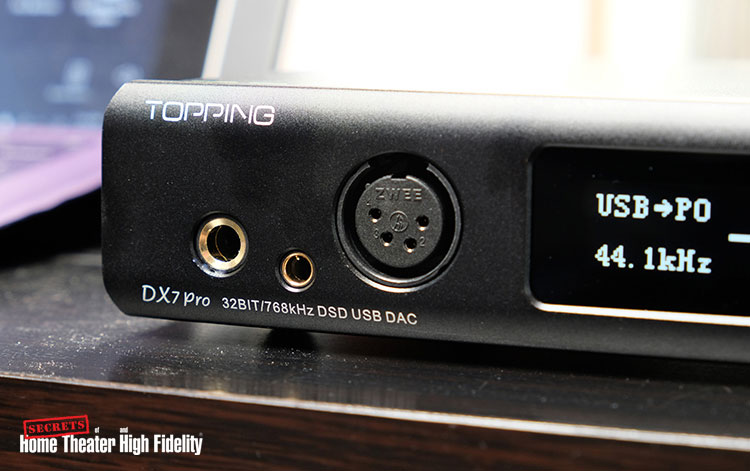
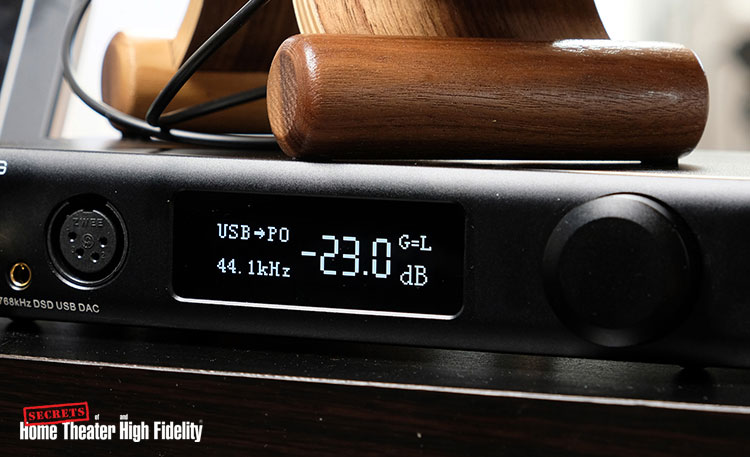
The front panel sports a single 1/4″-inch unbalanced phono plug jack, followed by a 4.4 mm (Pentaconn type) balanced jack, and then a 4-pin balanced XLR jack. The Pentaconn connector is a new one to me but I understand that it is becoming more popular, and available, as a balanced connector on portable devices so it’s nice to see it as a choice here. The monochrome OLED display shows essential data clearly and concisely. The typical screen display information consists of source-to-output status, sampling rate, volume (larger digits), and amp gain level (if using headphones). To the right of the display is the Volume/Push-to-Standby knob which is my only physical gripe with the DX7PRO. While the knob itself is aluminum, the digital volume control has a plasticky “click-click-click” sound and feel to its travel that disrupts the otherwise upscale image of the product.
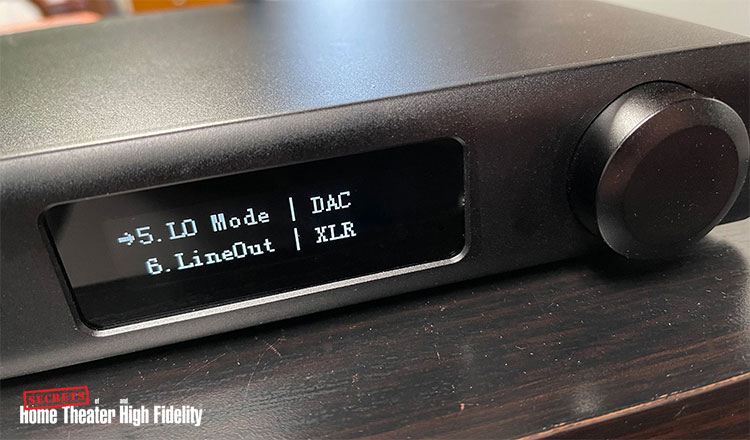
Pressing on this control while turning on the rear panel main power switch brings up a menu screen on the display where I could adjust several default parameters of the DX7PRO’s operation, including the choice of having it default as a straight DAC or preamp at startup, digital filter, and DSD filter settings, etc.
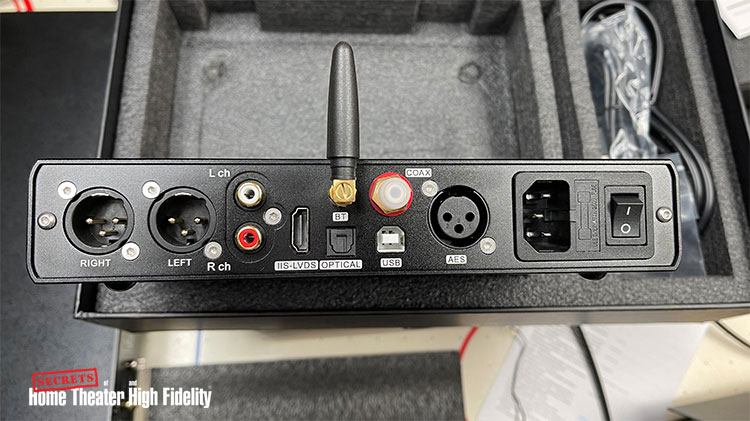
Switching to the back panel we see a pair of balanced XLR analog outputs, a pair of standard RCA analog outputs, an I2S digital input (HDMI connector), optical and coaxial SPDIF digital inputs, an asynchronous USB digital input, and an AES balanced digital input. The Bluetooth 5.0 antenna connector, IEC power cord socket, and power switch round out the menu here. A couple of interesting notes are that the Bluetooth connection is receive-mode only (no transmitting) so you can’t, for example, pair Bluetooth headphones to the DX7PRO. It does however support LDAC communication along with all flavors of aptX codecs, along with AAC and SBC codecs. Both the Optical and Coaxial digital inputs will accept PCM sampling rates up to 192 kHz (not always the case with optical) and accept DSD64 over DOP to boot.
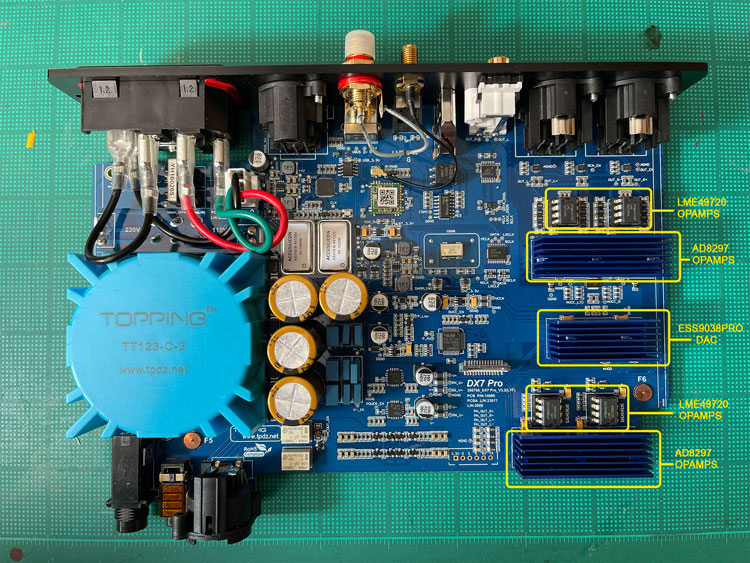
Things get more interesting on the inside of the DX7PRO where we find a nicely designed board with a clean layout and linear power supply. The DAC chipset is the top-shelf ESS ES3080PRO 8-channel DAC, used here in stereo mode and is covered by a substantial heatsink. Texas Instruments LME49720 OPAMPS are used in sockets for the line outputs. This means you can roll OPAMPS if you so choose but we recommend not to bother. Additional pairs of Analog Devices AD8397 OPAMPS, covered by the other two heatsinks have also been deployed. The Bluetooth chipset is the CSR8675 which supports the current BT 5.0 spec.
David Rich notes: Topping says the headphone driver is the LME49720 which is also used in the DAC filter stage. That chip can only drive 600 ohms. What really drives the headphones are a pair of AD8297. They are in little surface-mount packages and need those big heatsinks seen in the photo. The AD8297 can produce 310 mA peak into 32 Ω on ±12 V supplies. It’s fabricated with a special Analog Devices high-speed extra fast complementary bipolar high voltage process. It is not designed for audio. I expect it is used in a feedback loop with the LME49720 which sets the noise and distortion.
Strangely the same setup, complete with heatsinks on a pair of AD8297, is used for the current to voltage conversion stage of the ESS DAC. ESS DACs like really low feedback return resistors when their channels are paralleled, four per Left and four per Right. This keeps the feedback resistor’s thermal noise low. The LME49720 will not drive such a resistor. I assume the AD8297 gives the assist.
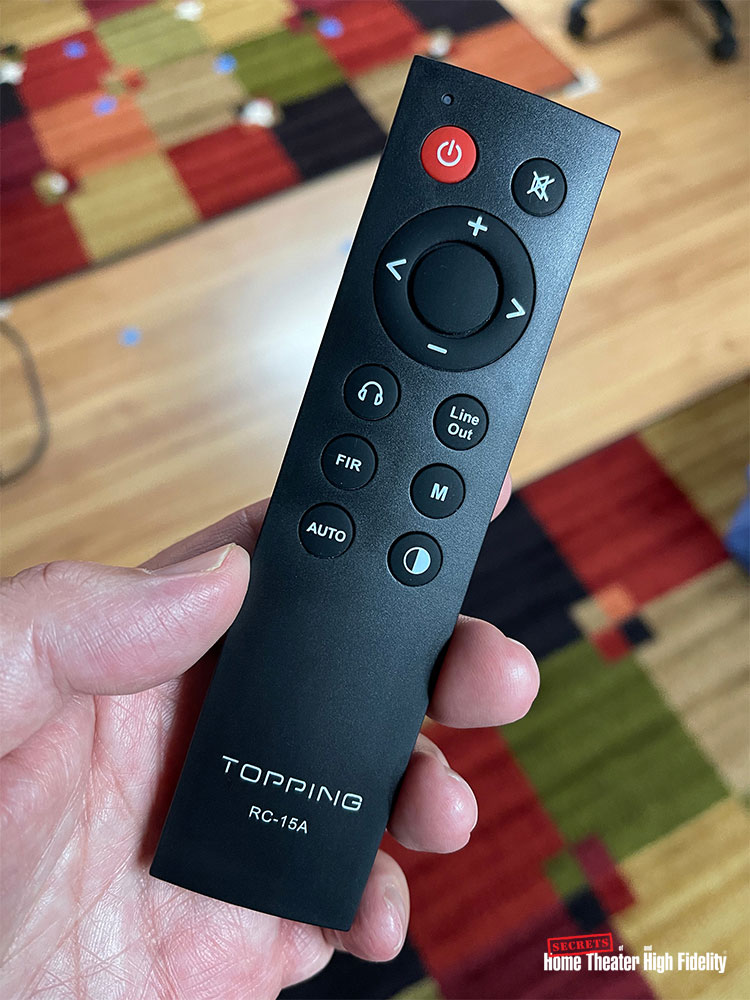
The DX7PRO comes with a slimline remote control that can control and access the majority of the unit’s features.
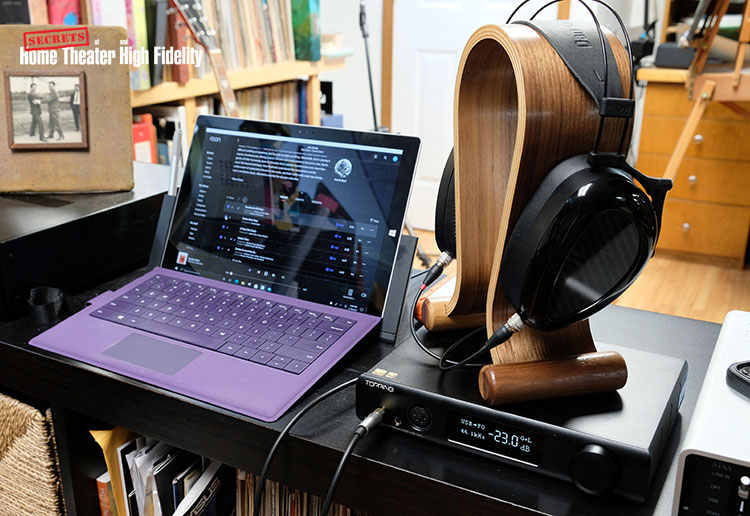
For the review, the Topping DX7PRO was connected to my Surface 3 Pro tablet and its desktop docking station running Windows 10. The tablet runs ROON core so it can access all my digital music and route it directly to the DX7PRO via USB. I had also installed the custom ASIO drivers that Topping makes available for download from their website.
I experimented with a wide variety of headphones when listening to the DX7 PRO. These included the HIFIMAN HE1000v2, and HE-R10, the Dan Clark Audio AEON 2 Noir, the Beyerdynamic DT 880PRO, and T5 Gen 3.

The Topping DX7PRO is very appealing to use on several levels. Its compact size makes it perfect for desktop use with a computer while its weight and tactile solidity give the DX7PRO a high-quality feel. Besides powering your headphones, it also can double as a solid little preamp for a pair of active speakers or a compact amplified system. And while the unit looks simple and unintimidating on its face, it pays to familiarize yourself with the slightly cryptic instruction pamphlet. There are a lot of options and default operating settings to fiddle with if you want. But once that is done with, day-to-day use was straightforward and easy. Both ROON and J.River Media Center had no issues communicating with the DX7 PRO via USB with either the ASIO or WASAPI drivers. No operational problems ever cropped up during my review period. The DX7PRO also played back both DSD256 and 24-bit/352.8 kHz PCM files natively with nary a whimper.
Secrets Sponsor
From a sound quality perspective, the Topping DX7PRO demonstrated itself to be an impeccably clean-sounding headphone amplifier. It was adept at driving whatever I connected to it, easily achieving comfortable volume levels with plenty of room to spare. My Beyerdynamic DT880PRO, for example, needed the High gain setting and were at a comfortable volume for me at -16 dB on the volume scale. These are 250-ohm headphones so I don’t see the DX7PRO encountering an issue driving 600-ohm cans effectively, should someone own a pair.
The DX7PRO also did not exhibit any coloration or impart any sounds of its own that I could discern. It was able to let me effectively latch on to the sonic characteristics and differences in the various headphones that I connected to it. When I compared it directly to my Benchmark Media HPA4’s headphone section, the Topping DX7PRO held its own very well. Especially considering that it is both a DAC and a headphone amp in one and that its price is about a quarter of what the Benchmark (a head amp only) is.
When comparing the sound of both, back-to-back using the same headphones, the Benchmark did elicit a little more body and impact to the sound of Mick Fleetwood’s drums when listening to “The Green Manalishi”, from the recent tribute concert to the late Peter Green. The same conclusion applied again when I loaded up the Tron Legacy soundtrack and cued up “End of Line”.
The electronic bass was just a touch punchier through the Benchmark HPA4 than the DX7PRO, but we are talking by a matter of degrees here, over a much wider price differential. Taken on its own, the Topping DX7PRO is a superb sounding DAC/headphone amplifier, and I couldn’t see it not meeting most discriminating listener’s needs. Unless you are looking for something that colors and warms the sound like a tube amplifier, the DX7PRO is a very smart piece of kit for the money. Do I have any gripes with the DX7PRO? Well, the feel of the volume knob travel that I mentioned earlier is the one thing that mars an overall elevated experience with this component. The movement feels fragile, with a plasticky click that makes me feel like I’ll break the volume control if I’m not careful. I would also trade the AES and I2S digital inputs (I don’t know anyone who uses them) for a pair of high-quality analog inputs in a heartbeat. I would expect those to be far more useful to an average user. But these are small complaints in the grand scheme of things. The Topping DX7PRO is an excellent choice for anyone serious about their headphone listening.
Measurements by Carlo Lo Raso with Analysis by Carlo Lo Raso and David A. Rich.
For THD and frequency response tests I used my Lynx 2B professional soundcard teamed with SpectraPLUS measurement software. For square wave analysis along with SNR measurements, I used the Quantasylum QA401 analyzer and its associated software.
When measured with a voltmeter the following values were observed at the outputs when a 1 kHz, 0 dB test tone was applied: 2.01 Volts at the RCA outputs and 4.02 Volts at the XLR outputs. This was with the DX7PRO either in exclusive DAC mode or Preamp mode with the volume set to maximum.
I am not equipped to perform headphone power output tests at this time.
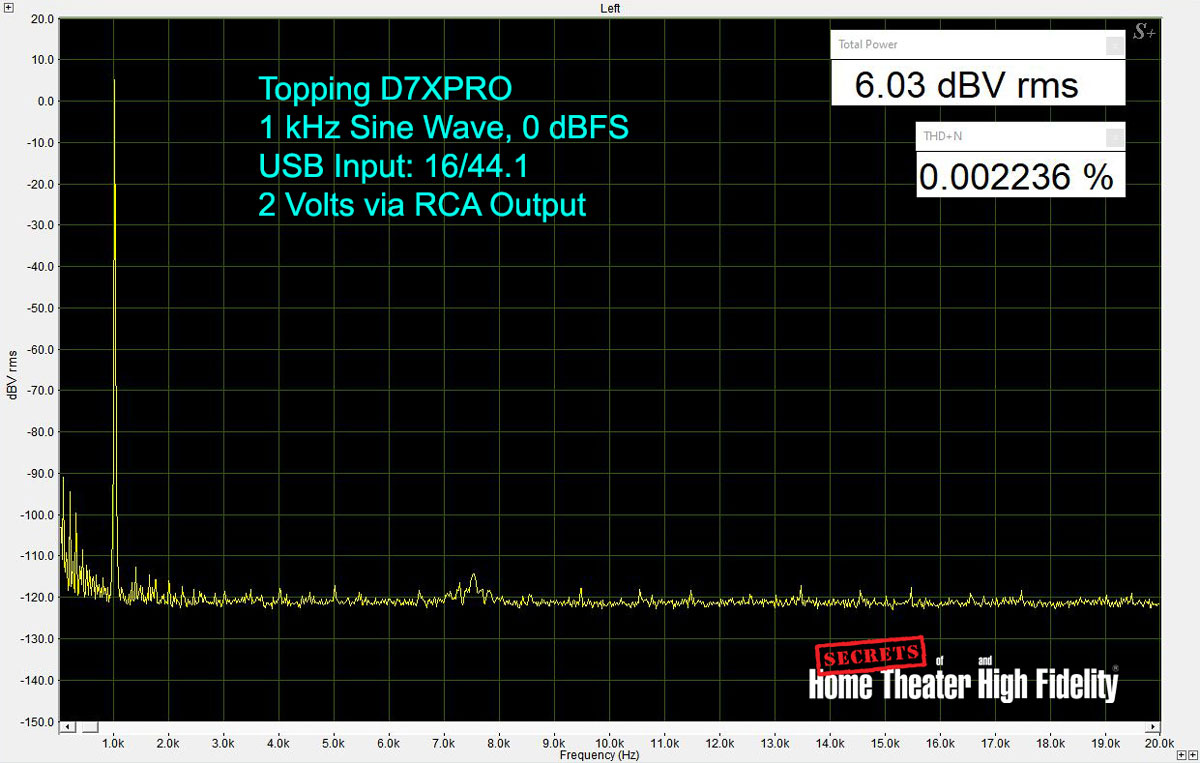
Here we have the first of the 16-bit 44.1 kHz tests. I did them through both the SPDIF Coax and USB inputs and the results proved to be essentially identical. I am showing the USB results here. Beginning with a 1 kHz test tone at 0 dBFS gives us a reported THD+N of just under 0.0022%. This was using the RCA outputs and at 2 VRMS, so we see some residual low-level ground noise.
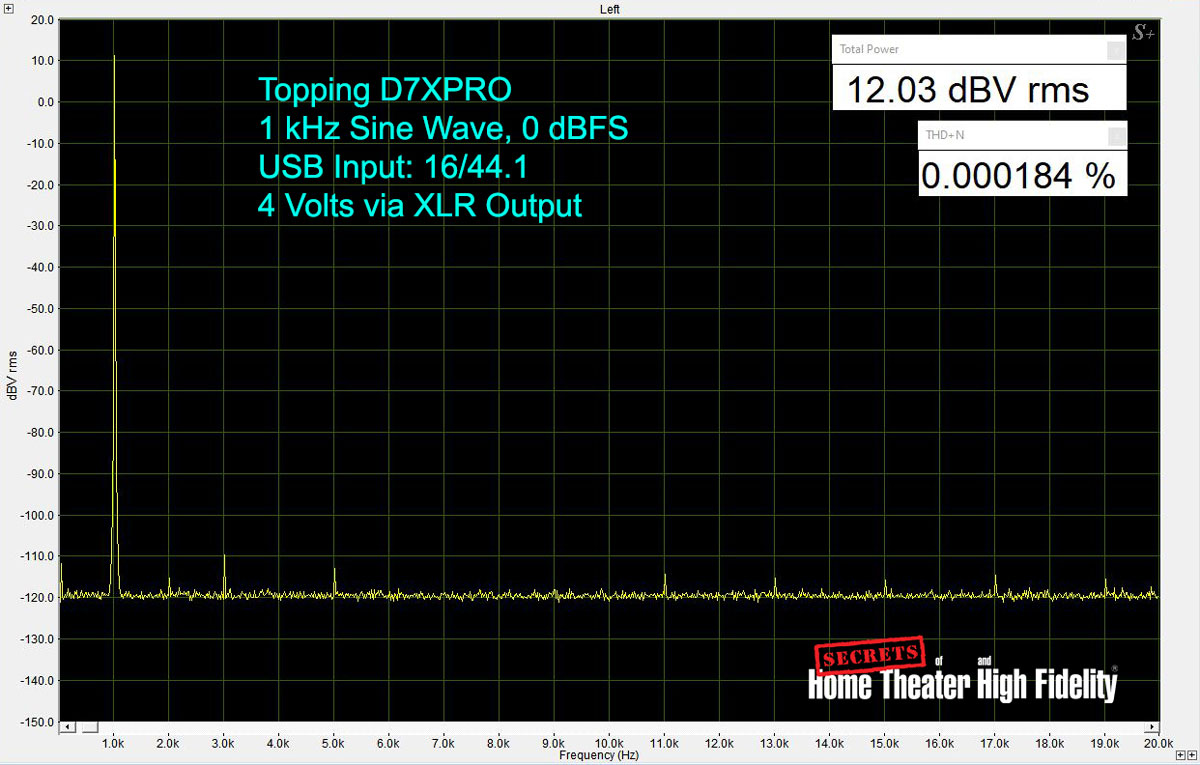
Repeating the same test using the XLR outputs at 4VRMS gives us a THD+N of 0.00018% along with better ground noise rejection. Not that you would hear it through the RCA jacks at the level it was.

A 16/44 10 kHz sine wave at 0 dB produces a THD + N of 0.00017% and a very clean spectrum.
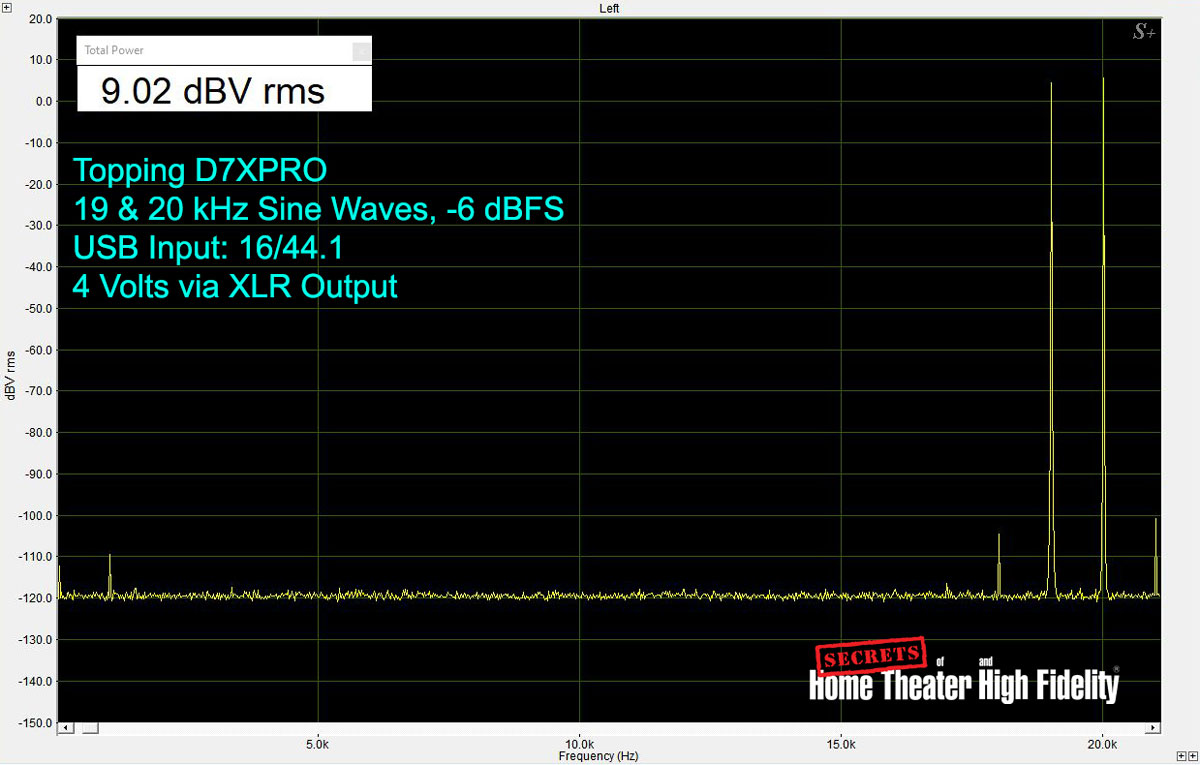
The 19 and 20 kHz test tones at -6 dBFS produce clean results with only 2 minor sidebands, both being over 100 dB below the fundamental tones. A small visible B-A peak at 1kHz is at 117 dB below the fundamental. In general, the Topping DX7PRO shows excellent performance with most Redbook CD standard tests.
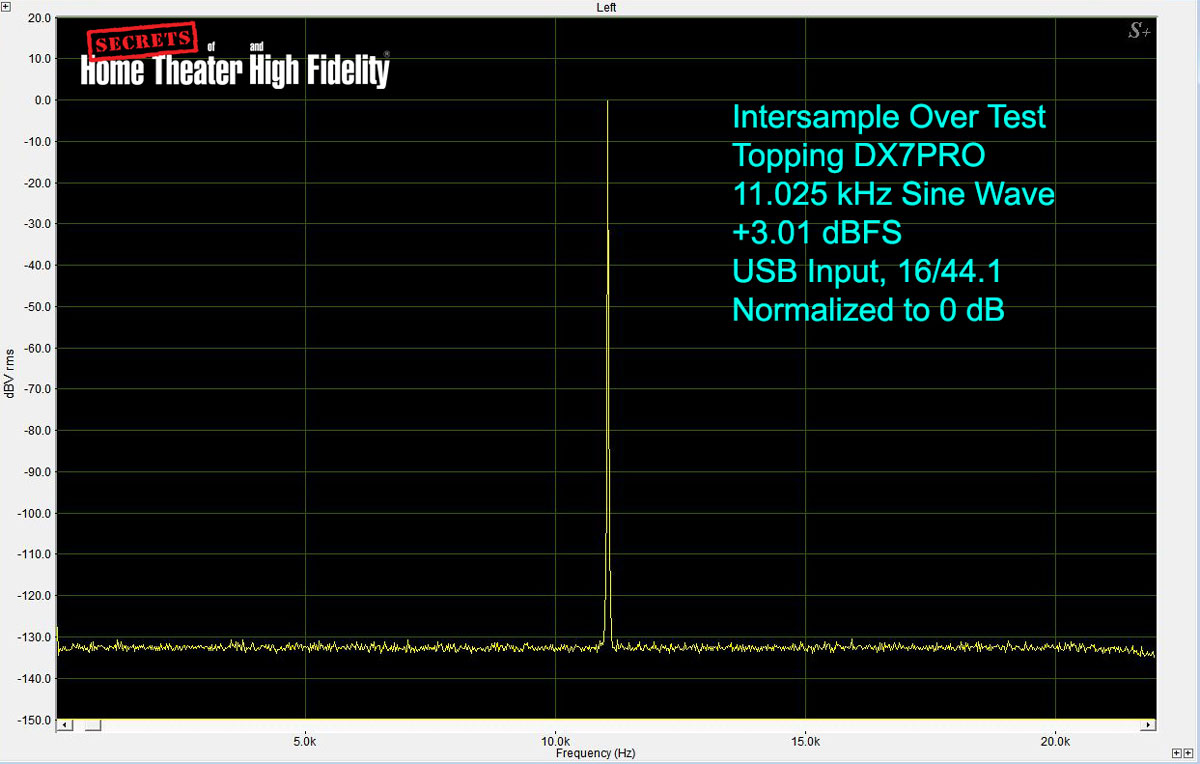
The Intersample Over test, inspired by John Siau at Benchmark Media Systems. It consists of using an 11.025 kHz tone with +3.01 dB signal peaks occurring at a phase angle of 45-degrees from the sample clock. This puts the maximum waveform peaks (higher than 0 dB) between the digital samples. According to Siau, “If audio peaks always fell exactly on a sample, there would not be an intersample overload problem. Obviously, musical peaks rarely fall exactly on a sample and most often fall somewhere between samples. This means that most recordings will have peaks that are over 0 dBFS if the highest sample values are just reaching 0 dBFS.” This condition is more prevalent in 16-bit/44 kHz CD recordings and lower bitrate, lossy formats like MP3, and can produce DSP overload problems in DACs. A poor performing DAC would show several spurious tones with some possibly being audible during regular playback. The test results for the Topping DX7PRO show no spurious tones or distortion created by the test signal. A Benchmark application note goes into much greater detail with figures.
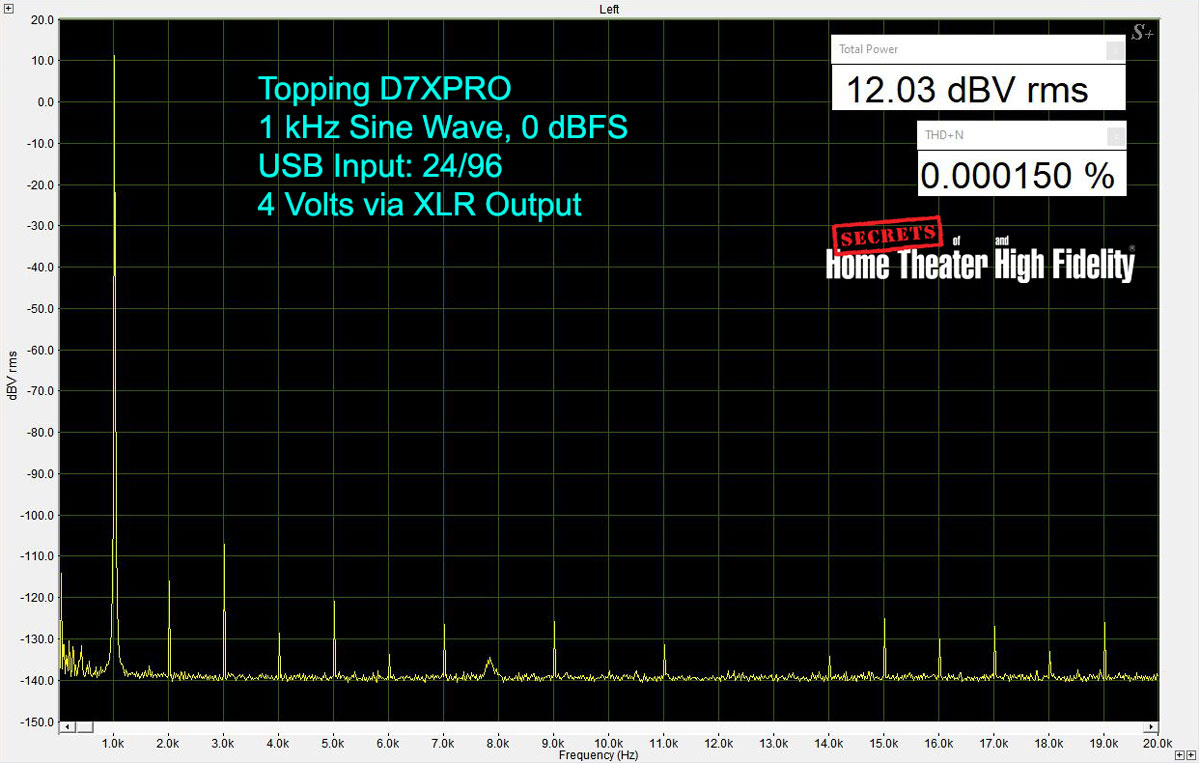
Moving to the 24-bit /96 kHz tests, a 1 kHz test tone at 0dBFS gives us a THD+N of 0.00015%. The 2nd and 3rd order harmonics register at 127 and 120 dB respectively below the fundamental tone. There looks to be a spur which is likely line noise that is 125dB below the fundamental. Completely inaudible.
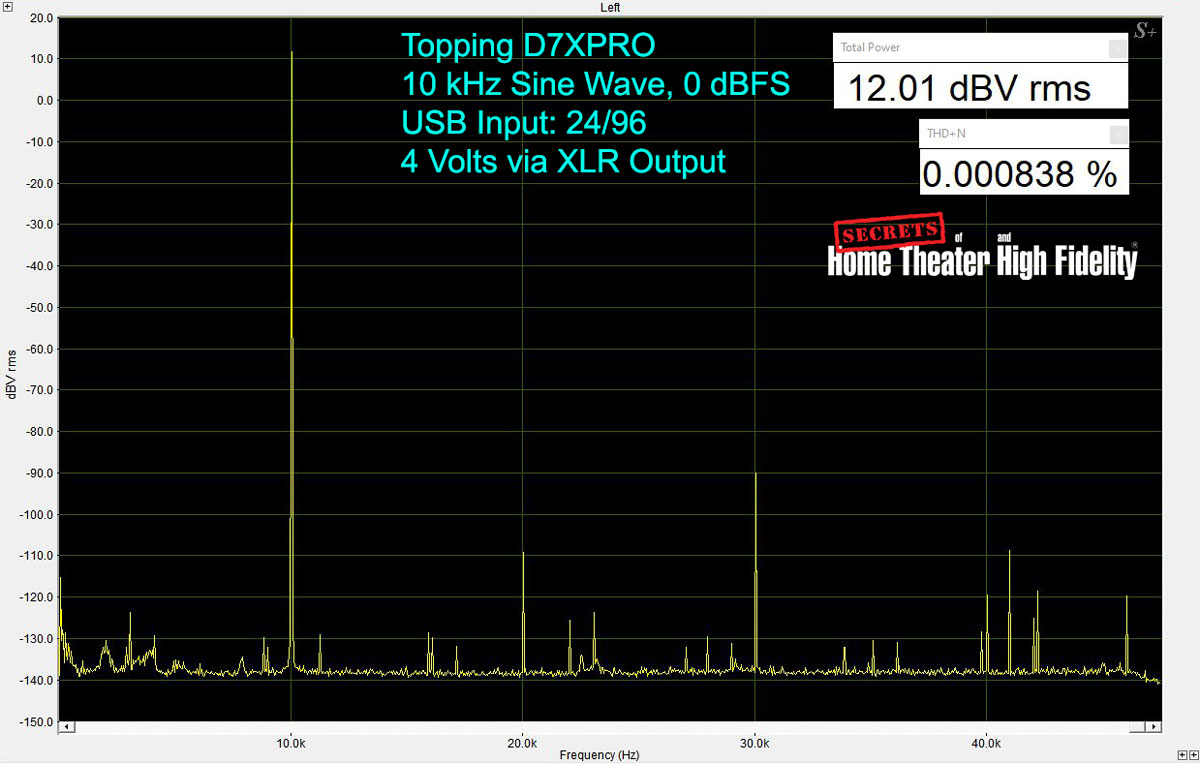
A 10 kHz tone of the same bit depth, sampling, and output level shows a THD+N of just over 0.00084%. The second-order harmonic checks in at 120 dB below the fundamental, with the third-order harmonic coming in at 112 dB below.
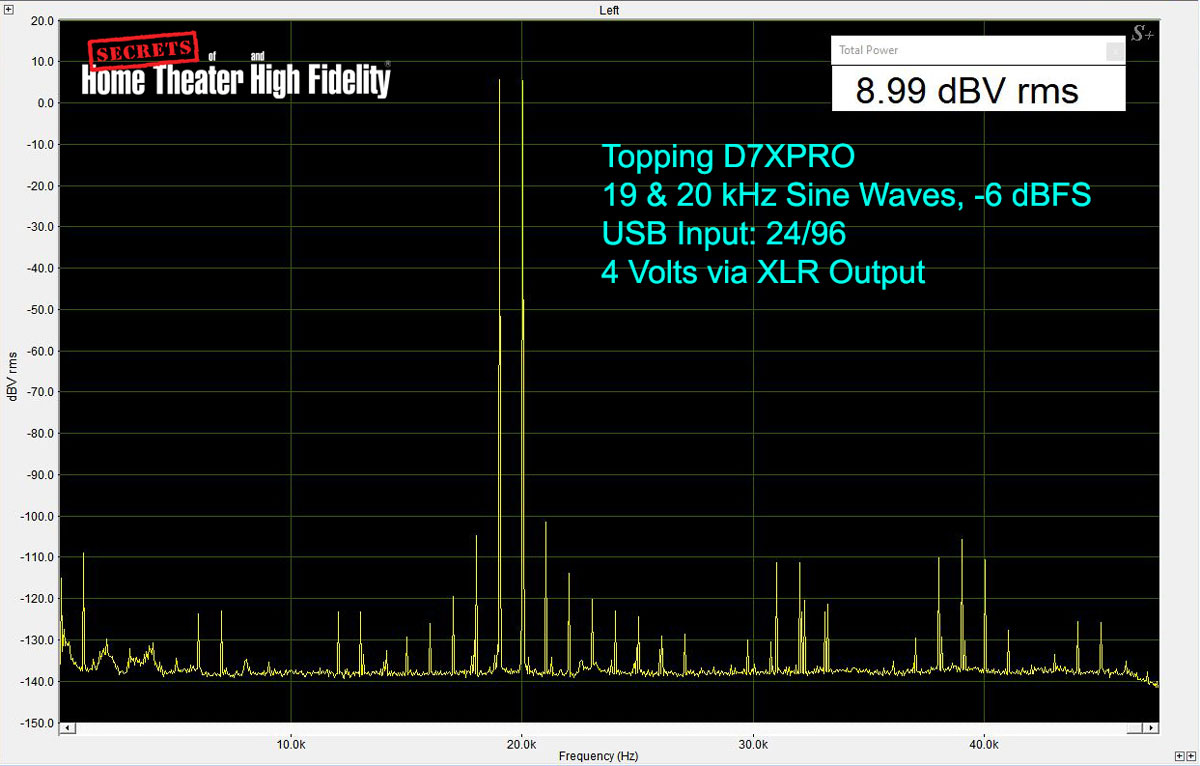
The 19 and 20 kHz dual-tone test at 24-bit/96 kHz with a -6 dBFS level reveals several distortion spurs through parts of the spectrum. A visible B-A peak at 1kHz is at 117 dB below the fundamental. The second-order harmonics at 38 and 40 kHz are at 117 dB and 118 dB below the fundamental, respectively.
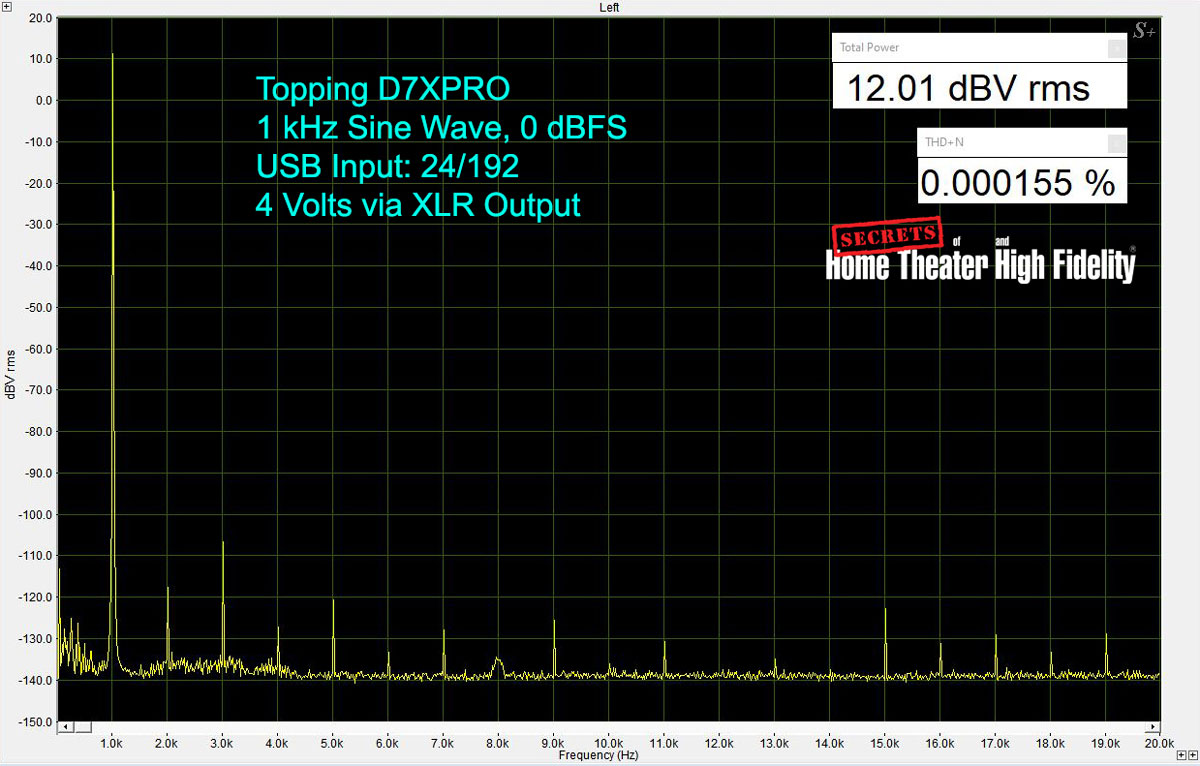


Above are the same three series of tests but done at 24-bit/192 kHz. The results for them are almost the same as the 24-bit/96 kHz tests. The 10 kHz test result is a closeup (20 Hz to 20 kHz bandwidth) for an alternate perspective.
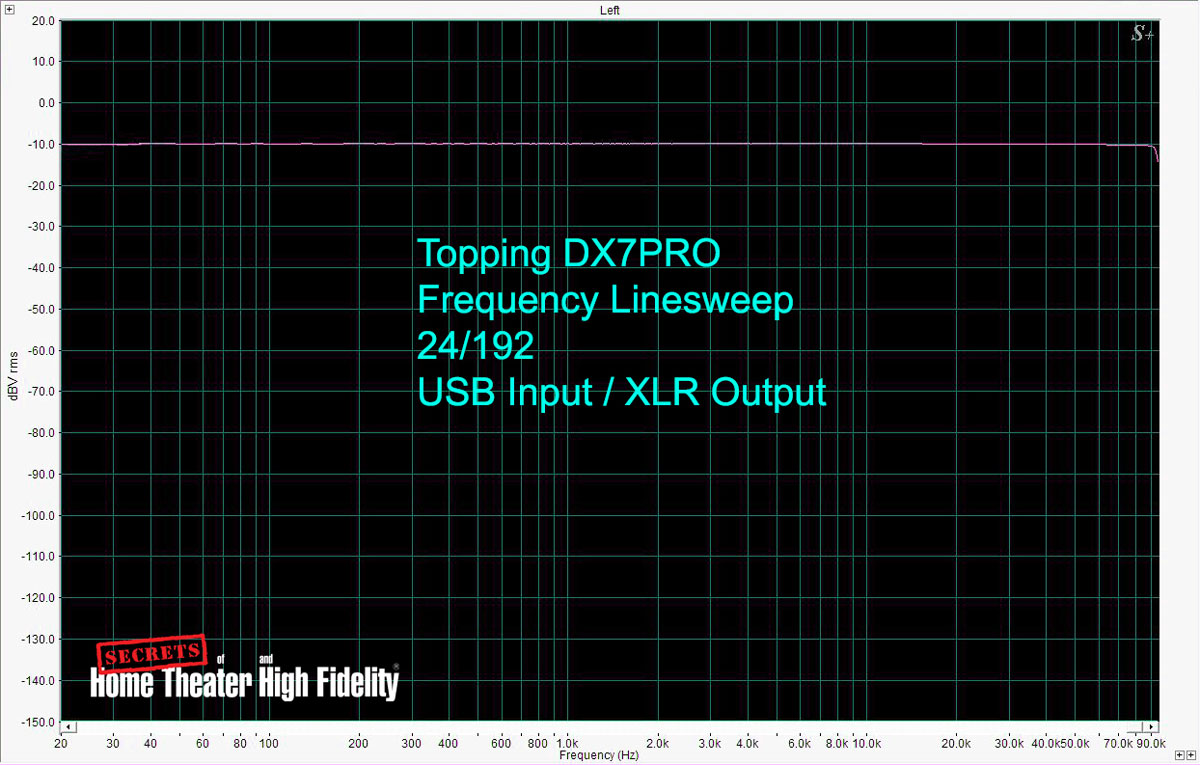
Here are the results for a frequency line sweep performed at 24-bit/192 kHz. The frequency response of the Topping DX7PRO is flat out to about 85 kHz before it begins to steeply roll-off.
Secrets Sponsor
The following digital filter tests, first suggested by Jurgen Reis of MBL Germany and used by John Atkinson of Stereophile, are designed to give us a look at the type and performance of the digital filter(s) that a given DAC uses. Unique to John Atkinson’s presentation is applying the Reis white noise only in the left channel. In the right channel is a 19 kHz tone. This tone will produce reconstruction spurs if the digital filter is not sharp enough to attenuate them. I’ve also combined the test results with the corresponding square wave that the filter would generate, for comparison. The DX7PRO offers 7 different reconstruction filters that can be selected, on the fly, via the button labeled “FIR” on the remote control.

Filter# 1 is an Apodizing Linear Phase filter with a fast roll-off. The plot shows that we get the first reconstruction tone down -95 dB (red trace). The passband (yellow trace) is nice and flat past 20 kHz and then the transition band falls like a brick. The stopband looks to be a consistent 97 dB.

Filter# 2 is a Minimum Phase filter with a slow roll-off. The first reconstruction tone is down a tiny 30 dB. The filter starts rolling off below 20 kHz. The transition band is really slow, as advertised in the name, and the stopband is deep.

Filter# 3 is a Minimum Phase filter with a fast roll-off. In this case, the first reconstruction tone is down by an excellent -110 dB. The passband remains flat to just past 20 kHz. The transition band drops quickly but the stopband seems shallow at only 65 dB.

Filter# 4 is a Linear Phase filter with a slow roll-off. The first reconstruction tone is down -25 dB (red). The filter is rolling off below 20 kHz in the passband. ESS added zeros not found in other slow linear phase filters. The zeros get the transition band curving down and falling into a deep stopband. They give the stopband a bumpy look.
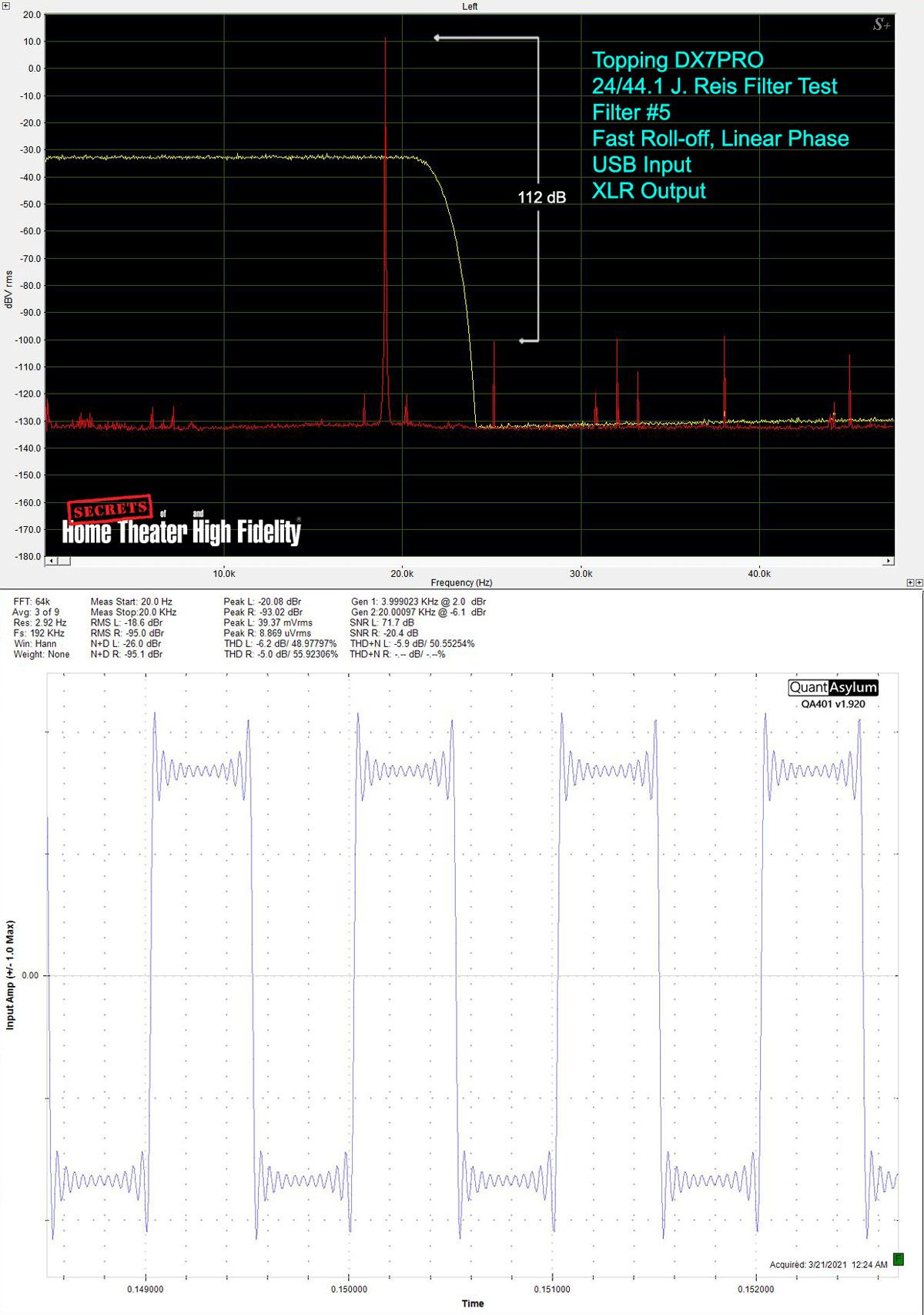
Filter# 5 is a Linear Phase filter with a fast roll-off. Here we get the first reconstruction tone down -112 dB (red trace). The passband is nice and flat past 20 kHz and then the transition band falls like a brick. Our test equipment is limiting seeing how deep the stop-band is (yellow trace). This is the filter I settled on for all my listening.
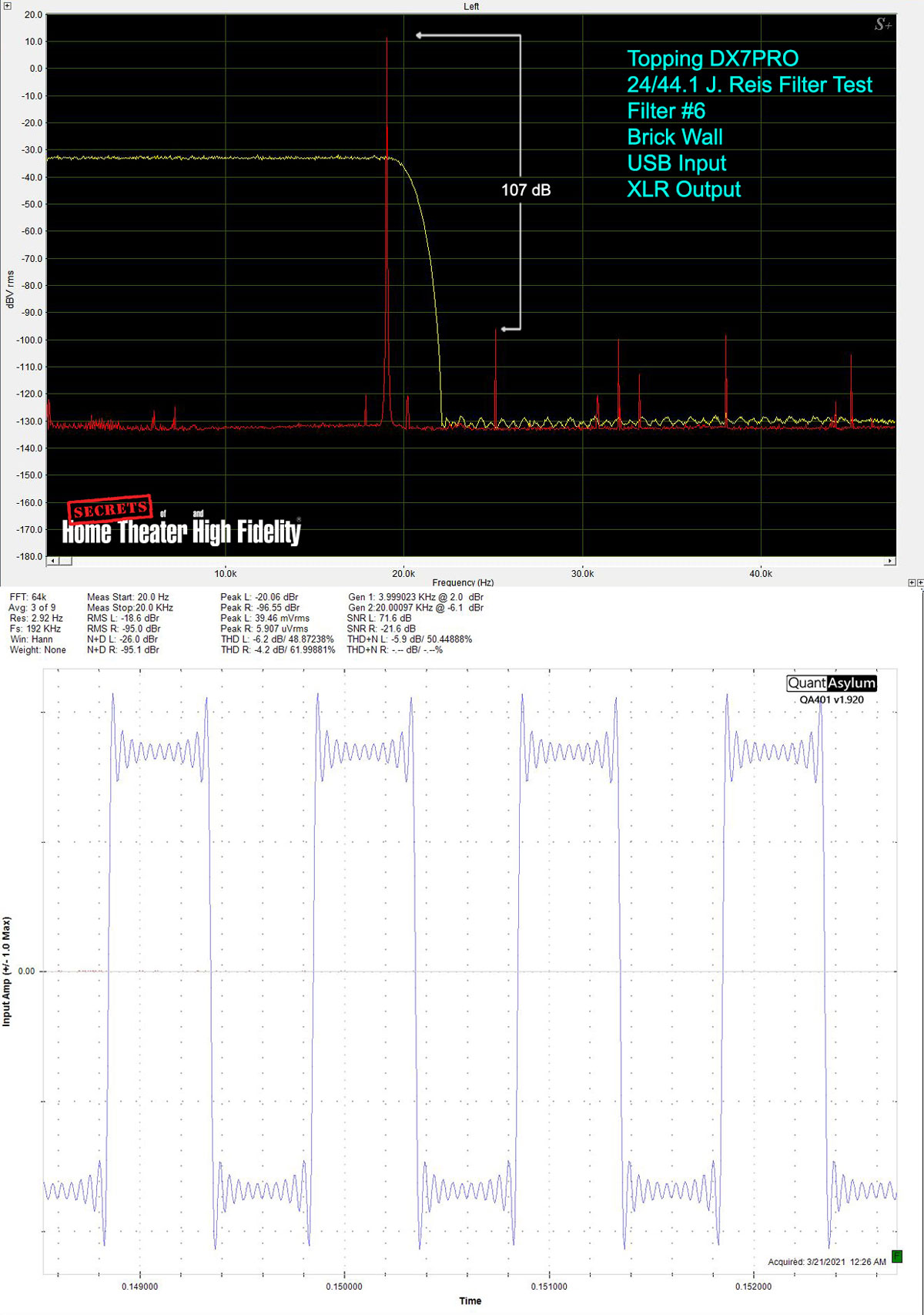
Filter# 6 is a Brick Wall type filter with a slow roll-off. This is like the Fast Roll-Off Linear Phase filter we saw earlier but they added more zeros in the stopband, note the bumps, to steepen up the transition band. It is like falling off a brick wall which is why they call this a “Brick Wall” filter. The first reconstruction tone down -107 dB (red trace) with the stopband at about 95 dB.
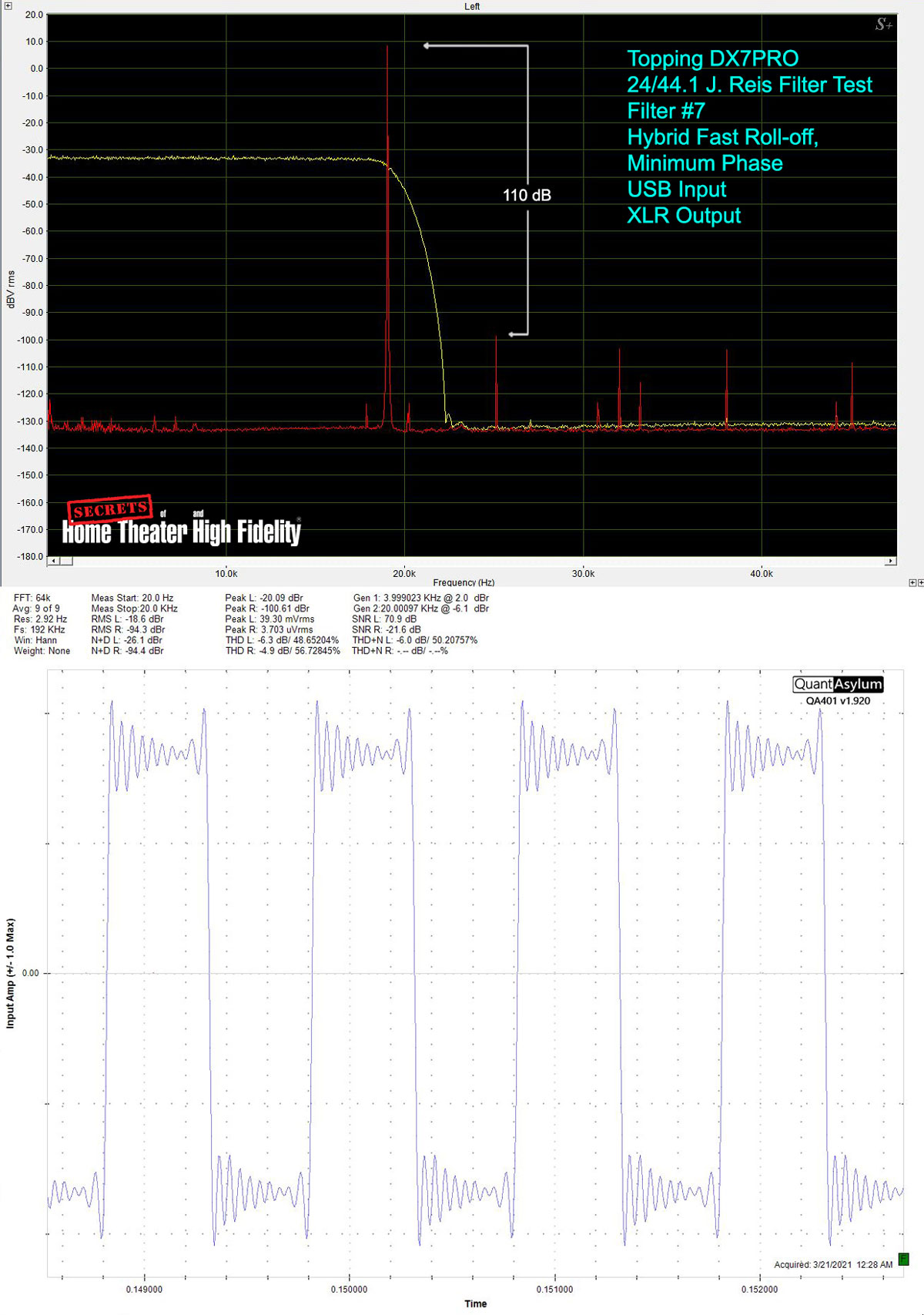
Filter# 7 is a Hybrid Minimum Phase filter with a fast roll-off. Here we get the first reconstruction tone down -110 dB (red trace). Unfortunately, the passband is rolling off before 20 kHz (and is down by at least 10 dB at that point) but then the transition band falls quickly with a nice deep stopband.
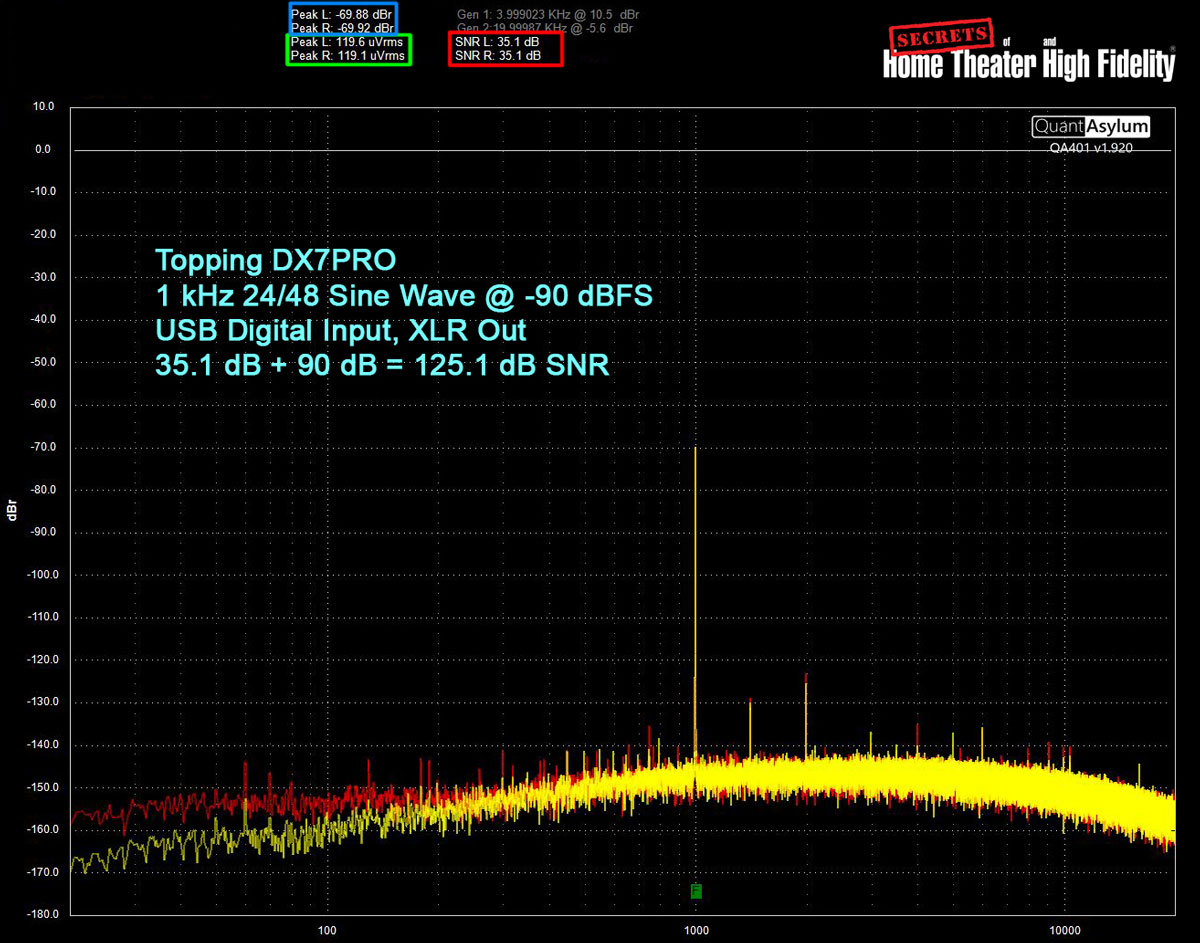
SNR measurements were done using the QuantAsylum QA401 Analyzer. Using a -90 dB 1 kHz test signal, we determined the digital SNR (A-Weighted) of the Topping DX7PRO to be 125 dB. Converted to bits that means the D7XPRO can resolve 20-bits. On the top of the spectrum, you see the SNR of the DX7PRO and then see the signal to noise of the left and right channels relative to the -90 dB tone (red box). We want the ratio of the full-scale signal to the noise, so we add 90 dB.
The DX7PRO uses a digital volume control which is part of the ESS chip. Removing the analog pot, that would otherwise be used for volume control, eliminates channel tracking errors. You also avoid needing to keep a can of contact cleaner around as the part degrades, although the typical controls in these types of units are sealed so when it goes bad it has to be replaced not sprayed. The idea of sealing the control is to provide longer life before it starts to degrade. Still, it will degrade.
A digitally controlled analog volume control solves the issues with the pot but they add distortion. Doing an analog volume with distortion numbers that approach the pot is expensive. The best approach is through using relays and a resistor ladder. That will exceed the performance of a pot but some people object to the clicks. High-reliability relays are not cheap, but this approach is becoming more popular in China-sourced products which are crashing the price to get this once exotic volume control.
The problem with removing the analog volume and doing things digitally before the DAC is the digital signal stream is reduced in size. Take the volume down by 2 (-6dB) and the MSB (Most Significant Bit) never toggles. So, the digital signal level is down but the DAC noise stays the same. The approach costs SNR. For our case of reducing the signal level 6 dB the SNR comes down 6 dB. In the past, with DACs that had a little more than 100 dB SNR, this would not work. You would quickly get below CD quality SNR. The Topping has an SNR of 125 dB. Moving the digital word down by half still provides 119 dB in theory. It still has a 19-bit resolution. In the figure below we check this.
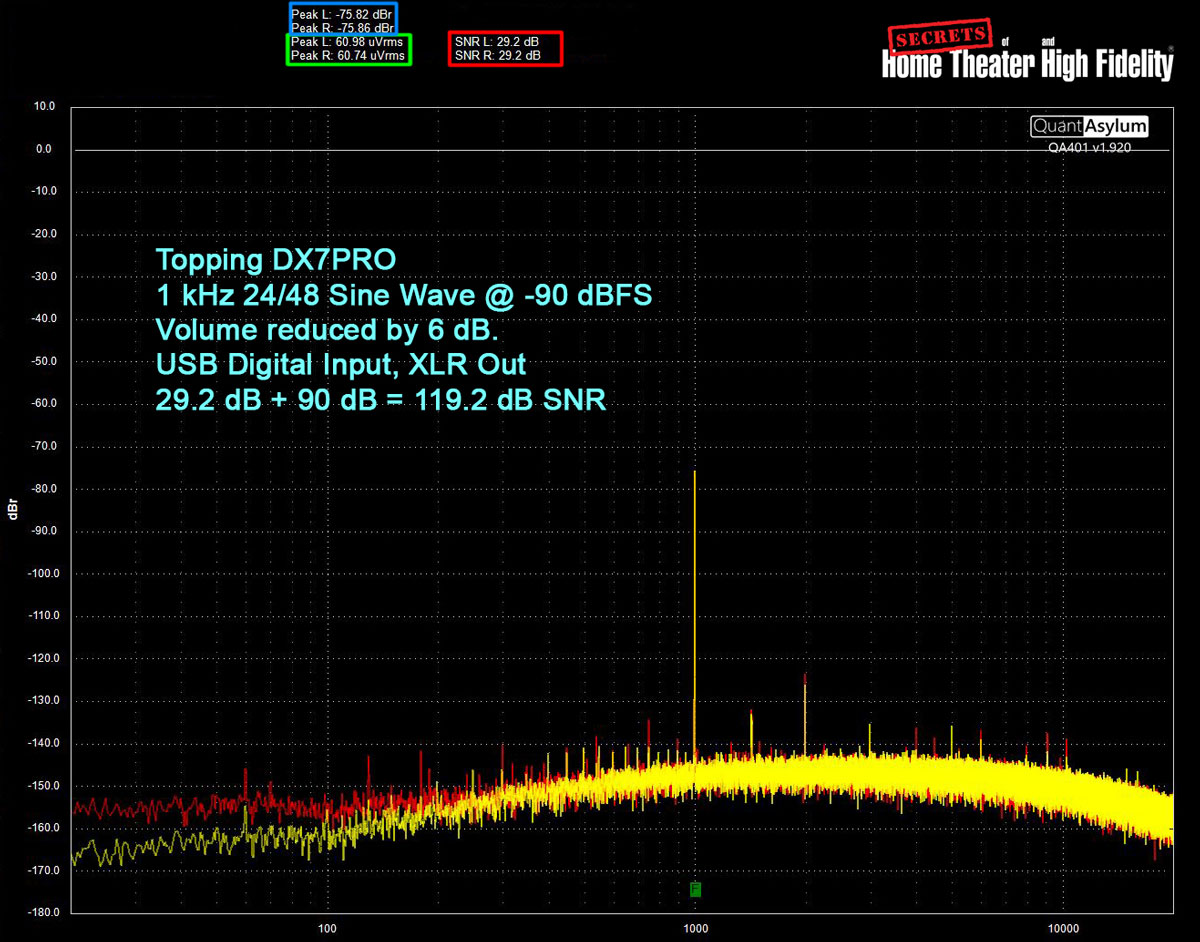
You can see the signal level has moved down from 120 uVRMS to 60 uVRMS. It has come down by half or -6dB. You can see the change in dB comparing the green boxes. The analog noise from the DAC has not changed. The DAC produces the same noise level regardless of the digital signal level. Our signal dropped by 6 dB so the SNR dropped 6 dB.
We add back 90 dB to the SNR to get the SNR relative to the 4VRMS full scale and get the expected 35.1 dB + 90 dB = 119.1dB. A loss of one bit.
With an analog volume reduced by a factor of two, the DAC noise and the signal would both be reduced and the SNR stays at 125 dB provided the analog volume, if implemented as digitally controlled, has that SNR or greater. If we moved the level control down by a factor of 10 (-20 dB) then the SNR would drop to 105 dB. That is still 17 bits. The subjective question is, can this loss of resolution be heard? Note that even the best relay-based analog preamp, the Benchmark HPA4 has an SNR of 137 dB. Taking it down -20 dB will bring its SNR down to 117 dB relative to the reduced (400 mVRMS) full-scale signal. It’s the noise of the preamp now limiting the SNR. It’s two bits better than the digital solution but until now very costly.
The good news is some headphone/DAC combos are now showing up with relay volume controls. Prices are dropping fast on relay-based products.
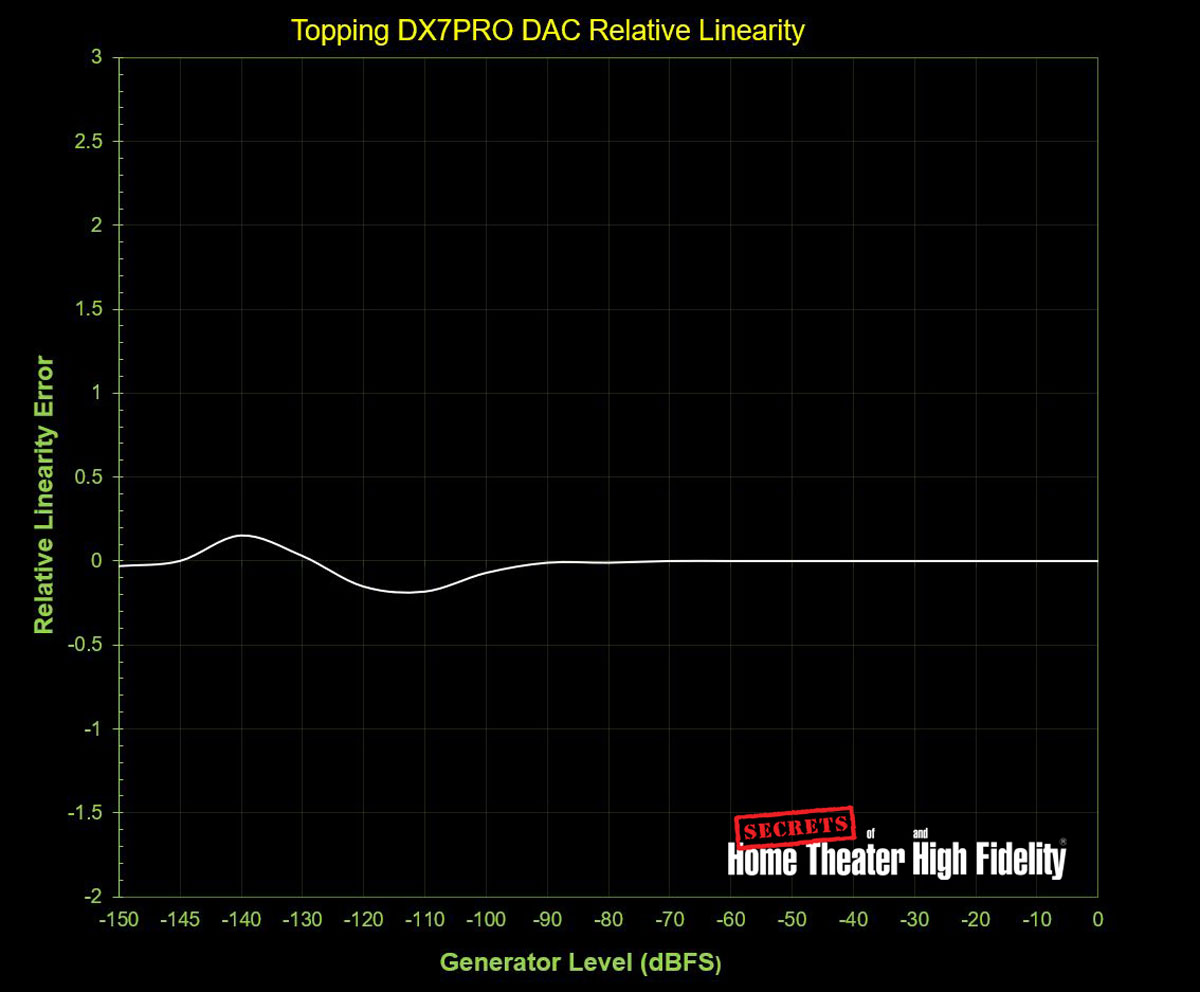
The above graph shows the relative line linearity performance of the Topping D7XPRO. The ESS ES9038PRO DAC architecture shows minimal amounts of deviation beginning at -90 dBFS in level. The largest deviations (-0.18 dB and 0.15 dB) occur at -110 dBFS and -140 dBFS respectively, after which the inconsistencies return to being much smaller. A very good result.
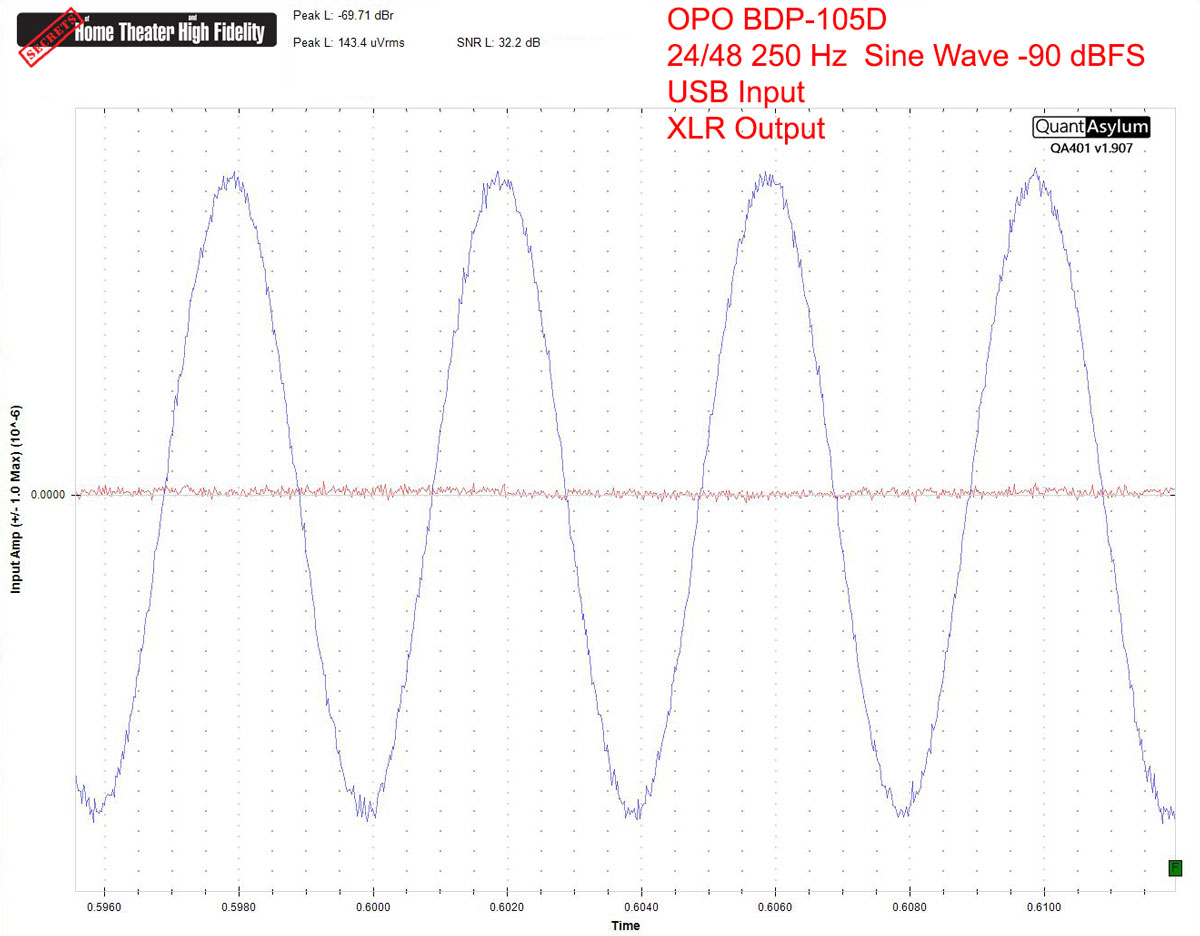
This is a time-domain plot of a -90 dBFS 250 Hz sine wave applied to the Oppo BDP-105D on the left channel. It is included here as a reference. The self-noise of the QA401 spectrum analyzer in time-domain mode is shown on the right channel as it is grounded. While obviously not a perfectly smoothly rendered sine wave, it is still incredibly complete for such a low signal level. This is the best result we have gotten so far in this test from available equipment; hence it’s used as a reference point. The BDP-105D has a signal-to-noise ratio of 122 dB without weighting which is what is shown. It had 124 dB with A-weighting which we used in the SNR measurement. As with the SNR, what is displayed here is relative to the waveform’s amplitude of -90 dB so what is shown is 32 dB. The signal level is 143 uVRMS.
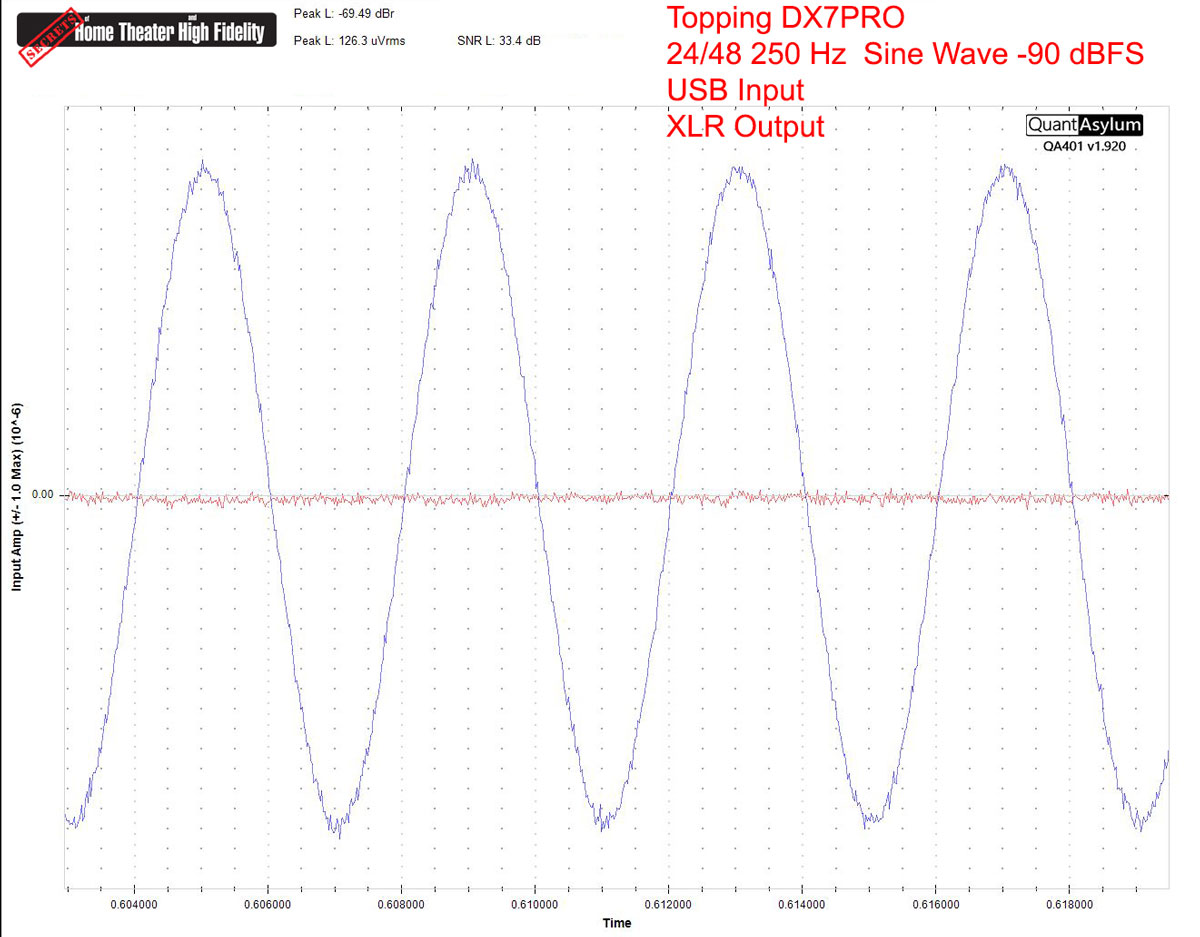
Here is the same plot for the Topping DX7PRO. The amplitude of the signal is a little less at 126 uVRMS. You can see how they look essentially identical, even though the DX7PRO has a slightly lower signal level its SNR is higher at 33 dB.
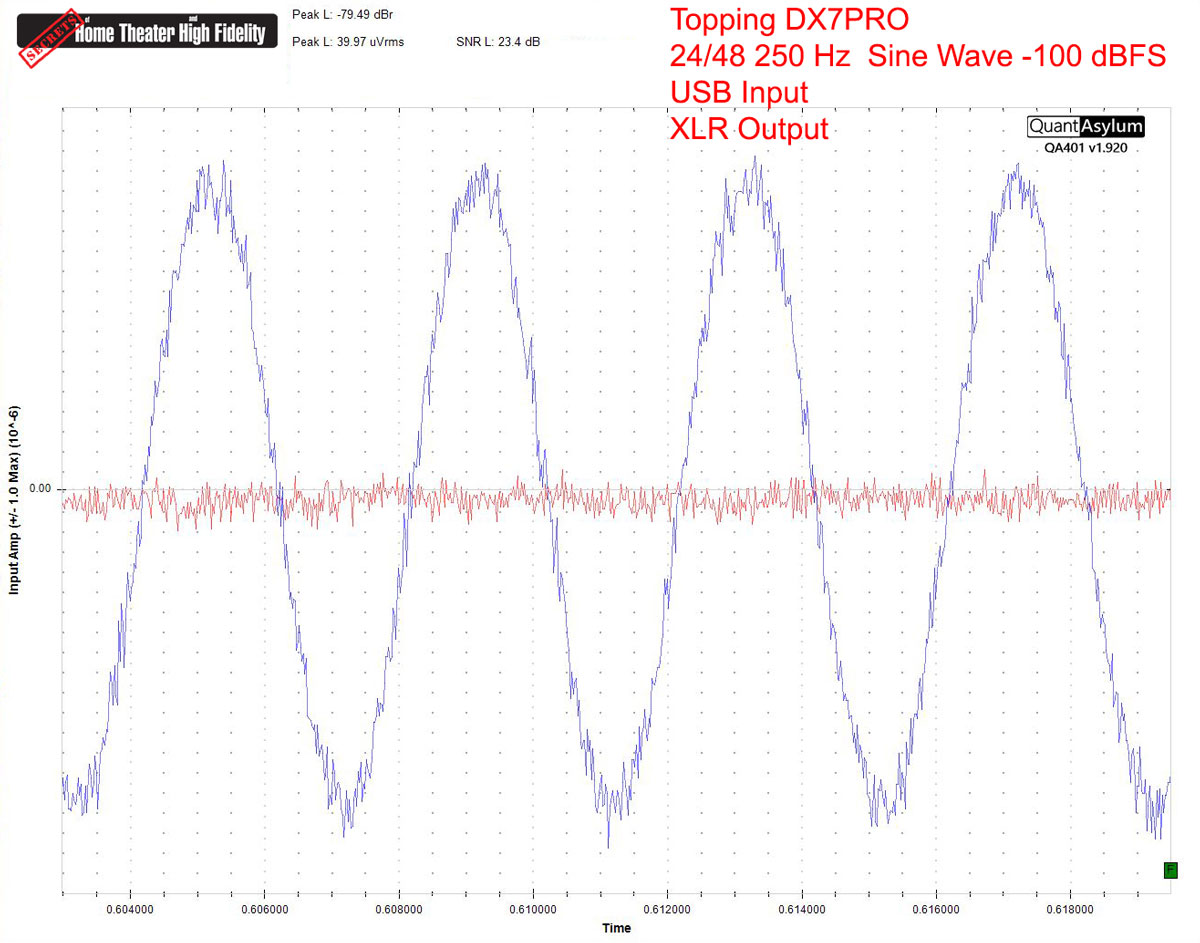
We’ve now dropped the level of the sine wave to -100 dBFS or 0.31 the size at -90 dBFS. The sine wave has an amplitude of 40 uVRMS. The signal to noise drops by 10 dB to 23.4 dB relative to the -100dB tone. This confirms the noise is up by a factor of 3 relative to the tone.
We could take the sine waves down two more notches, to -110 dBFS and -120dBFS where the signal and the noise become closer and closer in level, but you get the idea. The DX7PRO at least keeps up with the benchmark Oppo BDP-105D if not slightly surpasses it as the signals get to these almost ridiculously low levels. We are seeing SOTA DAC performance from a $650.00 box that you can plug a pair of headphones into.
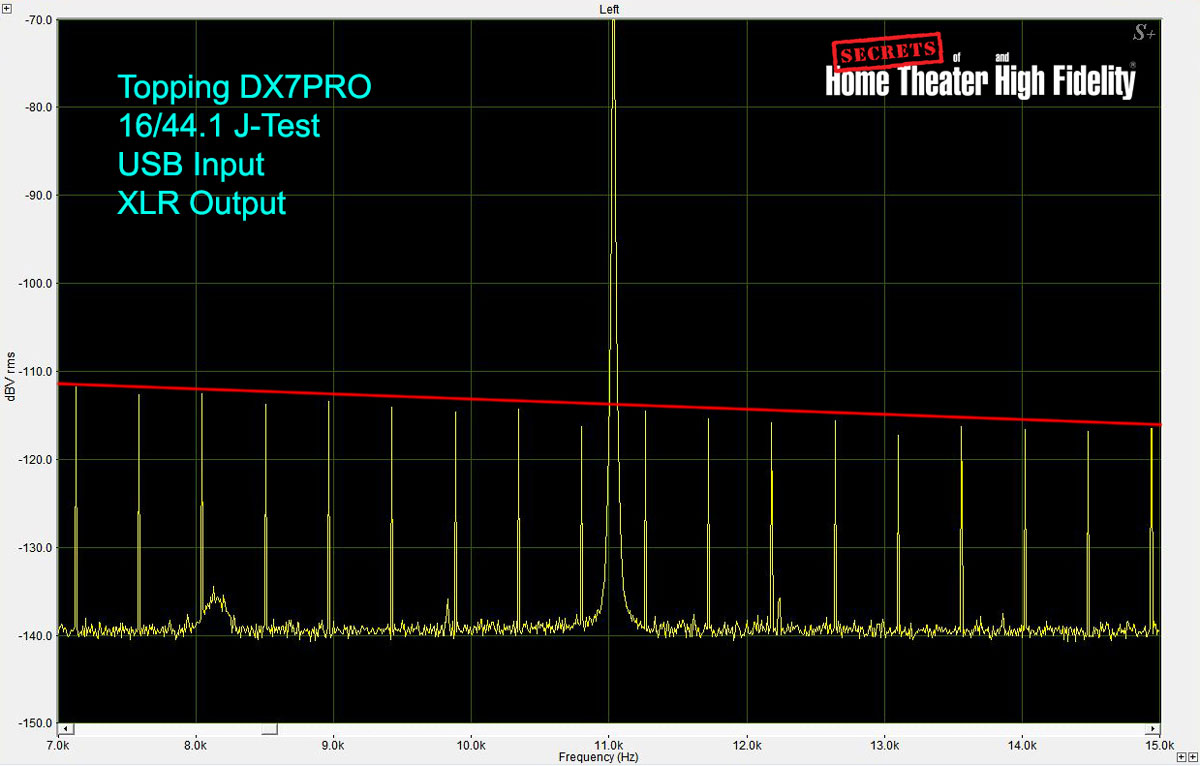
The final spectrum is the Julian Dunn J-Test for jitter at a sampling rate of 44.1k samples/sec. The test is close to an 11 kHz tone at –3 dBFS down and is a small, low-frequency square wave that creates activity in the PCM data which makes it harder for the clock recovery circuit to produce a clock without some phase noise. I used a 16-bit test tone generated by REW introducing the square wave at an amplitude of the smallest level possible for 16-bit data which is called the least significant bit. An excellent explanation of the J-Test and the spurs the test produces can be found here.
John Atkinson identifies the spur’s amplitude and frequency of the J-Test in absence of jitter. John then comes up with an innovative line to be placed on a spectrum of the analog output of a DAC box which is reproducing the J-Test. Any spur below the line is inherent in the test and not from the DAC box.
As can be seen, the jitter of the Topping DX7PRO is below the limits of the test. The small residual spurs between the lines are small enough that we cannot tell if it is jitter from the DX7PRO or the ADC we use to translate the signal back to digital to produce the spectrum.
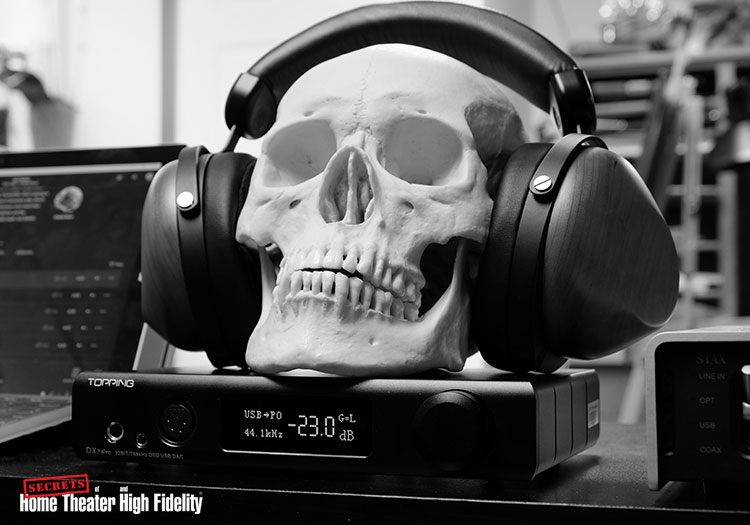
The Topping DX7PRO DAC/headphone amplifier provides a superb level of performance at a price most of us can happily afford.
- Excellent sonics with a variety of headphones.
- Small footprint.
- Solid build quality and design.
- perhaps the addition of one analog input.
- Better feel to the volume knob action.
The Topping DX7PRO, from both an objective and subjective view, is an outstanding DAC/headphone amplifier combination. You get a premium-looking component on the outside with premium parts and engineering on the inside. Its performance was such that it not only drove a wide assortment of headphones effectively, but it also didn’t leave any significant sonic imprint of its own. The Topping DX7PRO allowed me to fully enjoy and judge the quality of any headphone I plugged into it on their own merits. For its price, the DX7PRO provides an excellent value-to-performance ratio. Enthusiastically recommended!
The author would like to thank David A. Rich for his invaluable assistance in this review and to Aoshida HiFi for loaning us the review sample.


